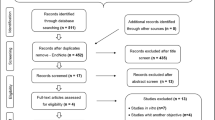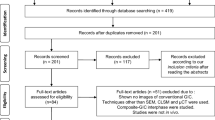Abstract
Purpose
To evaluate the influence of the addition of chlorhexidine on the antimicrobial effect and on the survival of restorations performed with glass ionomer cement.
Methods
Nine databases were used to search for randomized clinical trials that compared the survival rate and the antimicrobial effect of glass ionomer cement (GIC) restorations with and without the incorporation of chlorhexidine (CHX), without restrictions on year or language. Cochrane Collaboration’s Risk of Bias 2 was used to assess the risk of bias. The GRADE approach was used to assess the certainty of evidence.
Results
From 593 studies found, seven met the inclusion criteria. The concentration of CHX varied between 0.5 and 2%. In general, the addition of CHX to GIC promoted reductions in Streptococcus mutans and Lactobacillus acidophilus burdens when compared to those without CHX. No study showed a difference in the survival of restorations between GIC with CHX and conventional GIC. Individual risk of bias varied from low to high and the certainty of evidence was classified as very low.
Conclusions
Based on a very low level of certainty, the evidence suggests that the incorporation of CHX in GIC might improve the antimicrobial effects for a short time, in addition to having little influence on the survival of the restoration.


Similar content being viewed by others
Availability of data and materials
The data sets generated during and/or analysed during the current study are available from the corresponding author on reasonable request.
Code availability
Not applicable.
References
Abuzenada BM, Souror Y, Waly A, Khlifa Y. Mutans streptococci growth on glass ionomer incorporated with chlorhexidine: in-vivo study. Br Dent Sci. 2020;23(2):1–7. https://doi.org/10.14295/bds.2020.v23i2.1909.
Bellis CA, Nobbs AH, O’Sullivan DJ, Holder JA, Barbour ME. Glass ionomer cements functionalised with a concentrated paste of chlorhexidine hexametaphosphate provides dose-dependent chlorhexidine release over at least 14 months. J Dent. 2016;45:53–8. https://doi.org/10.1016/j.jdent.2015.12.009.
de Castilho AR, Duque C, Negrini TC, Sakono NT, Paula AB, Costa CAS, Spolidório DMP, Puppin-Rontani RM. In vitro and in vivo investigation of the biological and mechanical behaviour of resin-modified glass-ionomer cement containing chlorhexidine. J Dent. 2013;41(2):155–63. https://doi.org/10.1016/j.jdent.2012.10.014.
da Silva MER, Danelon M, Souza JAS, Silva DF, Pereira JA, Pedrini JA, et al. Incorporation of chlorhexidine and nano-sized sodium trimetaphosphate into a glass-ionomer cement: effect on mechanical and microbiological properties and inhibition of enamel demineralization. J Dent. 2019;84:81–8. https://doi.org/10.1016/j.jdent.2019.04.001.
Delany GM, Patterson SS, Miller CH, Newton CW. The effect of chlorhexidine gluconate irrigation on the canal flora of freshly extracted necrotic teeth. Oral Surg. 1982;53:518–22. https://doi.org/10.1016/0030-4220(82)90469-8.
Duque C, Aida KL, Pereira JA, Teixeira GS, Perrone LR, Caiaffa KS, Negrini TC, Castilho ARF, Costa CAS. In vitro and in vivo evaluations of glass-ionomer cement containing chlorhexidine for Atraumatic Restorative Treatment. J Appl Oral Sci. 2017;25(5):541–50. https://doi.org/10.1590/1678-7757-2016-0195.
Freire MCM, Reis SCGB, Figueiredo N, Peres KG, Moreira RS, Antunes JLF. Determinantes individuais e contextuais da cárie em crianças brasileira de 12 anos em 2010. Rev Saude Publica. 2013;47(Supl. 3):40–9. https://doi.org/10.1590/S0034-8910.2013047004322.
Frencken JE, Imazato S, Toi C, Mulder J, Mickenautsch S, Takahashi Y, Ebisu S. Antibacterial effect of chlorhexidine-containing glass ionomer cement in vivo: a pilot study. Caries Res. 2007;41(2):102–7. https://doi.org/10.1159/000098042.
Gomes BP, Vianna ME, Zaia AA, Almeida JF, Souza-Filho FJ, Ferraz CC. Chlorhexidine in endodontics. Braz Dent J. 2013;24(2):89–102. https://doi.org/10.1590/0103-6440201302188.
Guyatt G, Oxman AD, Akl EA, et al. GRADE guidelines: 1. Introduction-GRADE evidence profiles and summary of findings tables. J Clin Epidemiol. 2011;64(4):383–94. https://doi.org/10.1016/j.jclinepi.2010.04.026.
Higgins JPT, Thomas J, Chandler J, Cumpston M, Li T, Page MJ, Welch VA (editors). Cochrane Handbook for Systematic Reviews of Interventions. 2nd Edition. Chichester (UK): Wiley; 2019.
Hiraishi N, Yiu CK, King NM, Tay FR, Pashley DH. Chlorhexidine release and water sorption characteristics of chlorhexidine-incorporated hydrophobic/hydrophilic resins. Dent Mater. 2008;24(10):1391–9. https://doi.org/10.1016/j.dental.2008.03.011.
Jedrychowski JR, Caputo AA, Kerper S. Antibacterial and mechanical properties of restorative materials combined with chlorhexidines. J Oral Rehabil. 1983;10(5):373–81. https://doi.org/10.1111/j.1365-2842.1983.tb00133.x.
Joshi JS, Roshan NM, Sakeenabi B, Poornima P, Nagaveni NB, Subbareddy VV. Inhibition of residual cariogenic bacteria in atraumatic restorative treatment by chlorhexidine: disinfection or incorporation. Pediatr Dent. 2017;39(4):308–12.
Kabil NS, Badran AS, Wassel MO. Effect of the addition of chlorhexidine and miswak extract on the clinical performance and antibacterial properties of conventional glass ionomer: an in vivo study. Int J Paediatr Dent. 2017;27(5):380–7. https://doi.org/10.1111/ipd.12273.
Lewinstein I, Zenziper E, Block J, Kfir A. Incorporation of chlorhexidine diacetate in provisional cements: antimicrobial activity against Streptococcus mutans and the effect on tensile strength in vitro. Int Endod J. 2012;45(11):1010–7. https://doi.org/10.1111/10.1111/j.1365-2591.2012.02063.x.
Macedo CR. Cuidados gerais e higiene oral para prevenção de cáries em crianças. Diagn Trat. 2010;15(4):191–3.
Marti LM, Da Mata M, Ferraz-Santos B, Azevedo ER, Giro EM, Zuanon AC. Addition of chlorhexidine gluconate to a glass ionomer cement: a study on mechanical, physical and antibacterial properties. Braz Dent J. 2014;25(1):33–7. https://doi.org/10.1590/0103-6440201302328.
Mobarak EH, Shabayek MM, El-Deeb HA, Mulder J, Hassan FM, Van der Sanden WJM, Frencken JE. Survival of occlusal ART restorations using high-viscosity glass-ionomer with and without chlorhexidine: a 2-year split-mouth quadruple-blind randomized controlled clinical trial. J Adv Res. 2019;17:117–23. https://doi.org/10.1016/j.jare.2019.01.015.
Mohammadi Z, Abbott PV. The properties and applications of chlorhexidine in endodontics. Int Endod J. 2009;42:288–302. https://doi.org/10.1111/j.1365-2591.2008.01540.x.
Moher D, Liberati A, Tetzlaff J, Altman DG, The PRISMA Group. Preferred reporting items for systematic reviews and meta-analyses: the PRISMA statement. PLoS Med. 2009;6(7):e1000097. https://doi.org/10.1371/journal.pmed.1000097.
Murad MH, Mustafa RA, Schünemann HJ, Sultan S, Santesso N. Rating the certainty in evidence in the absence of a single estimate of effect. Evid Based Med. 2017;22(3):85–7. https://doi.org/10.1136/ebmed-2017-110668.
Pallan S, Furtado Araujo MV, Cilli R, Prakki A. Mechanical properties and characteristics of developmental copolymers incorporating catechin or chlorhexidine. Dent Mater. 2012;28(6):687–94. https://doi.org/10.1016/j.dental.2012.03.003.
Sidhu SK, Nicholson JW. A review of glass-ionomer cements for clinical dentistry. J Funct Biomater. 2016;7(3):16. https://doi.org/10.3390/jfb7030016.
Sterne JAC, Savović J, Page MJ, Elbers RG, Blencowe NS, Boutron I, Cates CJ, Cheng H-Y, Corbett MS, Eldridge SM, Hernán MA, Hopewell S, Hróbjartsson A, Junqueira DR, Jüni P, Kirkham JJ, Lasserson T, Li T, McAleenan A, Reeves BC, Shepperd S, Shrier I, Stewart LA, Tilling K, White IR, Whiting PF, Higgins JPT. RoB 2: a revised tool for assessing risk of bias in randomised trials. BMJ. 2019;366:l4898.
Takahashi Y, Imazato S, Kaneshiro AV, Ebisu S, Frencken JE, Tay FR. Antibacterial effects and physical properties of glass-ionomer cements containing chlorhexidine for the ART approach. Dent Mater. 2006;22(7):647–52. https://doi.org/10.1016/j.dental.2005.08.003.
Xueqing H, Tiantian Y, Suling Z, Cui H, Xijin D. Anti-biofilm effect of glass ionomer cements incorporated with chlorhexidine and bioactive glass. J Wuhan Univ Technol Mater Sci. 2012;27(2):270–5.
Yadiki JV, Jampanapalli SR, Konda S, Inguva HC, Chimata VK. Comparative evaluation of the antimicrobial properties of glass ionomer cements with and without chlorhexidine gluconate. Int J Clin Pediatr Dent. 2016;9(2):99–103. https://doi.org/10.5005/jp-journals-10005-1342.
Acknowledgements
We thank Camila Silva, Igor Felipe Lima and Walbert Vieira for their contributions to the study
Funding
This study was partially financed by the Coordination for the Improvement of Higher Education Personnel—Brazil (CAPES)—Finance Code 001, National Council for Scientific and Technological (CNPq)—Finance Code 307808/2018-1 and Research Support Foundation of the State of Minas Gerais (FAPEMIG).
Author information
Authors and Affiliations
Contributions
Victor da Mota Martins: Conception and design, acquisition of data, analysis and interpretation of data, drafting the manuscript, final approval. Luiz Renato Paranhos: Acquisition of data, analysis and interpretation of data, drafting the manuscript, final approval. Murilo Navarro de Oliveira: Analysis and interpretation of data, drafting the manuscript, final approval. Lucianne Couple Maia and Alexandre Coelho Machado: Drafting the manuscript, final approval. Paulo Cesar Freitas Santos-Filho: Conception and design, analysis and interpretation of data, drafting the manuscript, final approval.
Corresponding author
Ethics declarations
Conflict of interest
The authors declare that they have no competing interest.
Ethics approval
Not applicable.
Informed consent
Not applicable.
Additional information
Publisher's Note
Springer Nature remains neutral with regard to jurisdictional claims in published maps and institutional affiliations.
Rights and permissions
About this article
Cite this article
da Mota Martins, V., Paranhos, L.R., de Oliveira, M.N. et al. Does the addition of chlorhexidine to glass ionomer cements influence its antimicrobial effect and survival rate? A systematic review. Eur Arch Paediatr Dent 23, 365–379 (2022). https://doi.org/10.1007/s40368-022-00699-6
Received:
Accepted:
Published:
Issue Date:
DOI: https://doi.org/10.1007/s40368-022-00699-6




